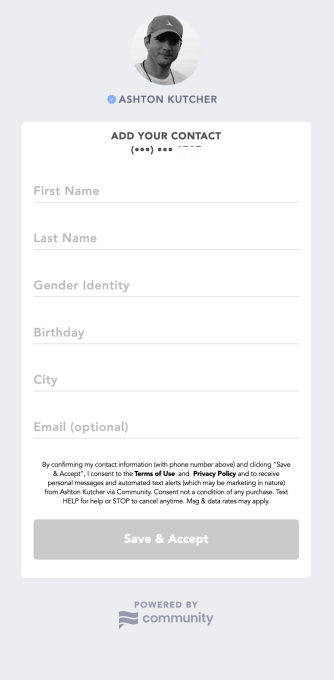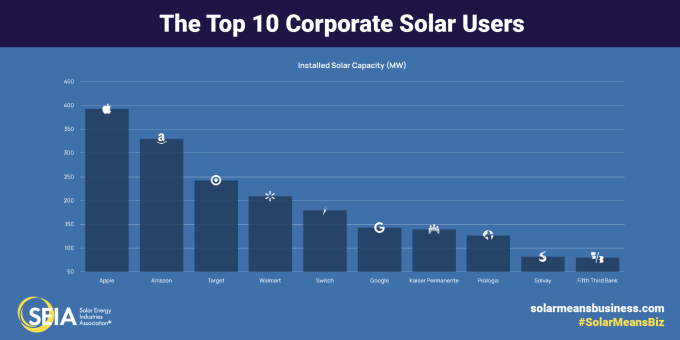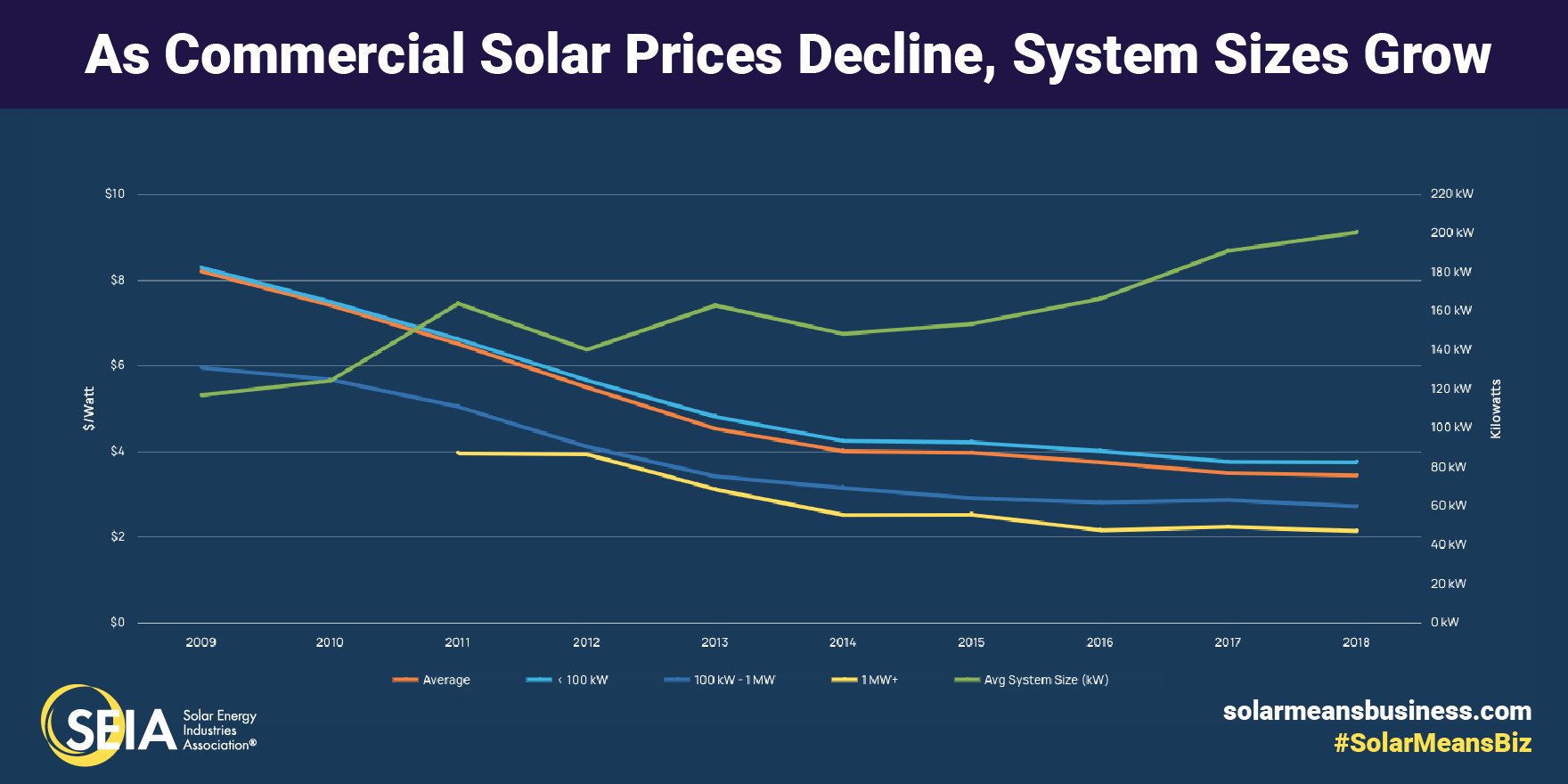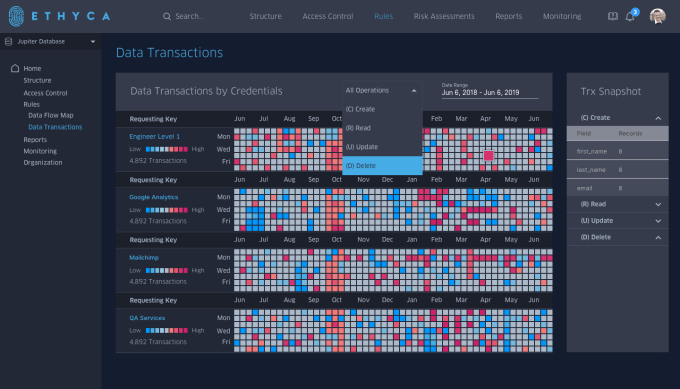An inside look at the startup behind Ashton Kutcher’s weird tweets
In 2017, Matthew Peltier walked barefoot into a pitch meeting with venture capitalists. Young, male, man bun intact, he certainly resembled the stereotypical successful entrepreneur, but it was his startup, an app designed to bring social media stars and their fans into conversation, that drew skepticism.
Shimmur, as it was called, ultimately succeeded in raising about $7 million from Greycroft, Arena Ventures, Luma Launch, Right Side Capital Management and Techstars, according to PitchBook, but the business never took off. That is until a pivot to direct messaging in 2018 attracted the support of Hollywood talent manager Guy Oseary and his Sound Ventures investment partner Ashton Kutcher, who jumped on board to relaunch Shimmur, now known as Community.
The Santa Monica-based company has raised nearly $35 million in the form of two convertible notes following a recapitalization that occurred alongside its rebranding earlier this year, TechCrunch has learned. Investors, including the Sony Innovation Fund, have valued the text marketing platform at upwards of $200 million, sources tell TechCrunch. A spokesperson for Community, however, said there is currently “no valuation attached to the company” because of the nature of the recap and convertible notes, and declined to comment further on fundraising activity.
Community has yet to complete a public launch and is in the process of onboarding both companies and celebrities. We’re told efforts to generate attention for the business will increase in the next couple of weeks.
Shimmur was initially conceived of in 2014 as a Reddit-style mobile application that encouraged users to join “Tribes,” or groups, where they could create and upload content about their favorite YouTube or Instagram stars. Social media accounts affiliated with Shimmur went dark in 2017, and in early 2018 the site began redirecting to Digits.Chat, a service currently in private beta assumedly linked to Community. Now in their second act, Peltier and Community co-founder Josh Rosenheck are committed to building a platform for influencers and fans to interact at scale.
Questions of Community’s business began to surface in January 2019, when Ashton Kutcher took to Twitter to subtly promote the service with a phone number and a simple request to text him. Naturally, many assumed the tweet included the actor and investor’s personal cell number. In reality, he’d been working with Community to develop a better method of communication with his followers. This week, the actor resurfaced on Twitter to promote the service again. This time stating that the phone number included in the tweet would be “the only place [he] responds to public queries” because the “open web has just become too toxic.”
Just text me it’s easier. +1 (319) 519-0576
— ashton kutcher (@aplusk) July 23, 2019
This reporter, of course, followed up Kutcher on his offer and sent a text to his now preferred contact. Instantaneously, I received this reply: “Ashton here. This is an auto-text to let you know I got your message, the rest will be from me. Click the link so I can respond to you. I likely can’t respond to everything but I’ll try to be in touch. Dream bigger.” The message was accompanied by a link to a Community sign-up page for Kutcher-specific updates. The fine print read that the personal messages and automated text alerts from Kutcher “may be marketing in nature,” but little other information was provided.

While Kutcher has used his large Twitter following to spread awareness for Community, Guy Oseary has remained mum. Sources tell TechCrunch, however, that Oseary is a “co-founder” of Community, further evidence he’s put money in the business and perhaps adopted a co-founder title because of the nature of his investment. Oseary is not only a co-founder of Sound Ventures alongside Kutcher, but he’s also a longtime executive at Maverick, an entertainment and music management business behind the likes of Madonna and U2. His network would be much more valuable to Community than VC dollars.
Sound Ventures, Kutcher and Oseary’s venture capital fund, did not respond to a request for comment. Community declined to name its investors, but did say Oseary is “not a co-founder,” declining to provide additional details on his affiliation with the business.
On its website, Community describes itself as a tool that enables its clients, e.g. influencers, musicians, athletes, brands, actors, their agents and others, to have direct and meaningful communication with their “community members” using a 10-digit phone number provided by Community: “Imagine getting to know and interact with your audience as individuals—with names and faces, interests and opinions, hometowns and pronouns. Imagine reaching every single one of them,” the company writes.
Peltier, in the company’s first blog post published in June, emphasized the power of text messaging, citing an Adobe statistic that 90% of text messages are read within three seconds. Peltier also described Community’s business model, noting that they are not an ads business, rather, clients pay Community monthly or annual service fees “for 100% audience reach and limitless segmentation, in a climate free from bullying and toxicity.” Community’s terms of service agreement additionally states that once a subscription is initiated, clients can create and send text marketing campaigns to promote themselves or products with members of their community.
If Community sounds familiar — it should. Its efforts to leverage SMS to facilitate celebrity-fan relationships is akin to SuperPhone. Founded by musician Ryan Leslie in 2015, SuperPhone is a mobile messaging platform designed to meet the needs of entrepreneurs, entertainers and anyone else that juggles clients or sales contacts.
“SuperPhone is the first foray into personal relationship management,” Leslie told TechCrunch last year. The startup has raised a total of roughly $5 million at a $10 million valuation, according to PitchBook. In a blog post addressing Kutcher’s January tweet, Leslie welcomed the competition to the text marketing space.
“The game is changing, messaging is here to stay, and platforms are stepping up to help you leverage the power of this currently undervalued direct communication channel,” Leslie wrote. “This is my game. SuperPhone was conceived, developed, deployed, and battle-tested years before this week’s A-list endorsement of text over social.”
We reached out to SuperPhone for comment and in a very on-brand reply, a spokesperson for the business told me to submit my phone number to Leslie here and “unlike Ashton, Ry will text you right back once you introduce yourself.”
Powered by WPeMatico
How top VCs view the new future of micromobility
Earlier this month, TechCrunch held its annual Mobility Sessions event, where leading mobility-focused auto companies, startups, executives and thought leaders joined us to discuss all things autonomous vehicle technology, micromobility and electric vehicles.
Extra Crunch is offering members access to full transcripts key panels and conversations from the event, including our panel on micromobility where TechCrunch VC reporter Kate Clark was joined by investors Sarah Smith of Bain Capital Ventures, Michael Granoff of Maniv Mobility, and Ted Serbinski of TechStars Detroit.
The panelists walk through their mobility investment theses and how they’ve changed over the last few years. The group also compares the business models of scooters, e-bikes, e-motorcycles, rideshare and more, while discussing Uber and Lyft’s role in tomorrow’s mobility ecosystem.
Sarah Smith: It was very clear last summer, that there was essentially a near-vertical demand curve developing with consumer adoption of scooters. E-bikes had been around, but scooters, for Lime just to give you perspective, had only hit the road in February. So by the time we were really looking at things, they only had really six months of data. But we could look at the traction and the adoption, and really just what this was doing for consumers.
At the time, consumers had learned through Uber and Lyft and others that you can just grab your cell phone and press a button, and that equates to transportation. And then we see through the sharing economy like Airbnb, people don’t necessarily expect to own every single asset that they use throughout the day. So there’s this confluence of a lot of different consumer trends that suggested that this wasn’t just a fad. This wasn’t something that was going to go away.
 For access to the full transcription below and for the opportunity to read through additional event transcripts and recaps, become a member of Extra Crunch. Learn more and try it for free.
For access to the full transcription below and for the opportunity to read through additional event transcripts and recaps, become a member of Extra Crunch. Learn more and try it for free.
Kate Clark: One of the first panels of the day, I think we should take a moment to define mobility. As VCs in this space, how do you define this always-evolving sector?
Michael Granoff: Well, the way I like to put it is that there have been four eras in mobility. The first was walking and we did that for thousands of years. Then we harnessed animal power for thousands of years.
And then there was a date — and I saw Ken Washington from Ford here — September 1st, 1908, which was when the Model T came out. And through the next 100 years, mobility is really defined as the personally owned and operated individual operated internal combustion engine car.
And what’s interesting is to go exactly 100 years later, September 2008, the financial crisis that affects the auto industry tremendously, but also a time where we had the first third-party apps, and you had Waze and you had Uber, and then you had Lime and Bird, and so forth. And really, I think what we’re in now is the age of digital mobility and I think that’s what defines what this day is about.
Ted Serbinski: Yeah, I think just to add to that, I think mobility is the movement of people and goods. But that last part of digital mobility, I really look at the intersection of the physical and digital worlds. And it’s really that intersection, which is enabling all these new ways to move around.
Clark: So Ted you run TechStars Detroit, but it was once known as TechStars Mobility. So why did you decide to drop the mobility?
Serbinski: So I’m at a mobility conference, and we no longer call ourselves mobility. So five years ago, when we launched the mobility program at TechStars, we were working very closely with Ford’s group and at the time, five years ago, 2014, where it started with the connected car, auto and [people saying] “you should use the word mobility.”
And I was like “What does that mean?” And so when we launched TechStars Mobility, we got all this stuff but we were like “this isn’t what we’re looking for. What does this word mean?” And then Cruise gets acquired for a billion dollars. And everyone’s like “Mobility! This is the next big gold rush! Mobility, mobility, mobility!”
And because I invest early-stage companies anywhere in the world, what started to happen last year is we’d be going after a company and they’d say, “well, we’re not interested in your program. We’re not mobility.” And I’d be scratching my head like, “No, you are mobility. This is where the future is going. You’re this digital way of moving around. And no, we’re artificial intelligence, we’re robotics.”
And as we started talking to more and more entrepreneurs, and hundreds of startups around the world, it became pretty clear that the word mobility is actually becoming too limiting, depending on your vantage where you are in the world.
And so this year, we actually dropped the word mobility and we just call it TechStars Detroit, and it’s really just intersection of those physical and digital worlds. And so now we don’t have a word, but I think we found more mobility companies by dropping the word mobility.
Powered by WPeMatico
CrunchMatch simplifies networking at TC Sessions: Enterprise 2019
Get ready to experience world-class networking TechCrunch-style at TC Sessions: Enterprise 2019. On September 5, more than 1,000 of the top enterprise software minds and makers, movers and shakers will descend on San Francisco’s Yerba Buena Center for the Arts. It’s a day-long conference featuring distinguished speakers, panel discussions, demos and workshops.
It’s also a prime opportunity to connect and build relationships with enterprise software founders, technologists and investors. Make the most of that opportunity by using CrunchMatch, our free business match-making service.
The automated platform lets you find people based on specific mutual business criteria, goals and interests. It helps you sift through the noise and make the most of your valuable time. After all, connecting with the right people produces better results.
Here’s how CrunchMatch (powered by Brella) works. When CrunchMatch goes live — several weeks before the main event — we’ll email a sign-up link to all ticket holders. You’ll be able to access the platform and create a profile with your specific details — your role (technologist, founder, investor, etc.) and a description of the types of people you want to connect with at the event.
CrunchMatch works its algorithmic magic and suggests meetings, which you can then vet, approve and schedule or decline. It’s an efficient and productive way to network. Take a look at how CrunchMatch helped Yoolox increase distribution.
All that time-saving efficiency will free you up to enjoy more of the presentations and hear from speakers like the renowned founder, investor, AI expert and Stanford professor, Andrew Ng. You won’t want to miss his take on how AI will transform the enterprise world — like nothing else since the cloud and SaaS. And that’s just a taste of what you can expect.
If you haven’t already done so, buy your tickets now and save $100 before the prices go up on August 9. Early-bird tickets cost $249 and student tickets sell for $75. Buy 4+ tickets to get the group rate and save another 20%.
ROI tip: For every ticket you buy to TC Sessions: Enterprise, we’ll register you for a free Expo-only pass to TechCrunch Disrupt SF 2019.
We can’t wait to see you at TC Sessions: Enterprise 2019 in San Francisco on September 5. Join your community, explore the top enterprise trends and companies and make productive connections with the influential people who can help you reach your goals. Buy your ticket today.
Interested in sponsoring TC Sessions: Enterprise? Fill out this form and a member of our sales team will contact you.
Powered by WPeMatico
Nearly a third of US households don’t have a broadband connection
Over the past several years, many have suggested that broadband internet should be regarded as a public utility, like water or gas. Staying connected has become an essential part of nearly every facet of life, but according to a new report, high-speed connections may not be as prevalent here in the States as you may think.
In its new Rural America and Technology study, NPD notes that 31% of U.S. households don’t have broadband (25Mbps downloads and up) internet connections. The number works out to roughly 100 million per the report. That figure, unsurprisingly, is highly concentrated in rural areas — less than one-fifth of that population has a broadband connection.
While broadband was considered something of a luxury in the not so distant past, it’s grown into an increasingly essential aspect of modern existence, from work to health to entertainment. The concentration of access to the technology in urban versus rural areas has been a major aspect in what analysts have referred to as the “digital divide.” Rural areas make up nearly 97% of the total U.S. land.
On the upside, the report suggests that 5G could have a profound impact on those numbers. “The roll out of 5G will have a significant impact in rural America, disrupting the limited broadband carrier market and delivering broadband to many households that have not previously had access,” NPD’s Eddie Hold said in a statement released with the report. “This will inevitably provide an opportunity for manufacturers and retailers to reach new consumers with advanced devices.”
Given the speed and spottiness with which the technology has been rolled out thus far, however, coupled with the high prices of first-generation handsets, it will likely take several years before that comes to pass.
Powered by WPeMatico
Airbud raises $4 million to add a voice interface to your website
Amazon’s Alexa ushered in a new dawn of user interfaces, bringing voice into the mix as a viable option. Dozens of companies have sprouted because of this, not least of which being Airbud.io.
Airbud allows any company to add a voice interface to its website. The company just closed a $4 million round led by Hanaco Ventures, with participation from ERA and Spider Capital.
Airbud was co-founded by Israel Krush, Uri Valevski and Rom Cohen after the team saw the growth of voice interfaces and wondered how to capitalize on it.
By allowing companies to add voice/chat bot utility to their websites, Airbud hopes to increase retention of end-users on sites and give them easier access to the information they seek. Krush says that Airbud is focusing on websites that you have to be on, rather than the ones you want to be on.
That means Airbud clients are mostly in the healthcare space and travel space, helping end-users find a physician or book a flight using their voice.
Most importantly, Airbud operates on a plug and play system, meaning that clients don’t have to do the usual heavy lifting involved in creating a chat bot. Most of the time, folks who implement chatbots have to build a conversation tree. Airbud uses existing information scraped from the website, paired with an easy plug-and-play system for clients, to automatically build out a knowledge graph and have conversations with end-users.
Airbud charges based on the number of indexed pages and traffic to those pages.
The company plans to use the funding to increase the size of its team from seven to 15.
Powered by WPeMatico
Apple leads corporate American solar energy usage
Apple led the way in solar usage as technology companies step up their development of renewable energy projects to offset their carbon emissions.
That’s the word from the Solar Energy Industry Association in its latest tally of leading corporate solar energy installers across the U.S.
Last year, Apple installed 400 megawatts of solar capacity to lead all companies in the U.S.
“Top companies are increasingly investing in clean, reliable solar energy because it makes economic sense,” said Abigail Ross Hopper, president and CEO of the Solar Energy Industries Association (SEIA), in a statement. “[And] corporate solar investments will become even more significant as businesses use solar to fight climate change, create jobs and boost local economies.”

Four of the top 10 corporate solar users in the U.S. were tech companies. Amazon was No. 2 on the Solar Energy Industry Association’s list of companies tapping solar energy to power their businesses. The data center company Switch and search giant Google (a subsidiary of Alphabet) came in as the fifth and sixth companies.
“Playing a significant role in helping to reduce the sources of human-induced climate change is an important commitment for Amazon,” said Kara Hurst, director of Sustainability, Amazon, in a statement. “Major investments in renewable energy are a critical step toward addressing our carbon footprint globally. We will continue to invest in these projects and look forward to additional investments this year and beyond.”
The price for solar continues to come down, which is increasing the adoption — and scale — of solar installations in the U.S.

According to the SEIA, the biggest jump in solar installations have happened in the last three years. In all, 7 gigawatts of solar capacity has been installed at commercial locations, which is enough to power 1.4 million homes.
Of course, these numbers still need to increase even more dramatically for the corporate world to show that it’s serious about addressing climate change. While it’s important to acknowledge the successes of companies that are taking strides to incorporate more renewable energy into their operations, the goal for these massive industrial and technology giants (and really the goal for every institution) should be to get to as close to full decarbonization as possible.
The world has 10 years to wean itself off its current emissions-heavy consumption habits. Increasing solar usage is a step in the right direction, but it’s only a step.
Powered by WPeMatico
Ethyca raises $4.2M to simplify GDPR compliance
GDPR, the European data privacy regulations, have been in effect for more than a year, but it’s still a challenge for companies to comply. Ethyca, a New York City startup, has created a solution from the ground up to help customers adhere to the regulations, and today it announced a $4.2 million investment led by IA Ventures and Founder Collective.
Table Management, Sinai Ventures, Cheddar founder Jon Steinberg and Moat co-founder Jonah Goodhart also participated.
At its heart, Ethyca is a data platform that helps companies discover sensitive data, then provides a mechanism for customers to see, edit or delete their data from the system. Finally, the solution enables companies to define who can see particular types of data across the organization to control access. All of these components are designed to help companies comply with GDPR regulations.

Ethyca enterprise transaction log (Screenshot: Ethyca)
Company co-founder Cillian Kieran says that the automation component is key and should greatly reduce the complexity and cost associated with complying with GDPR rules. From his perspective, current solutions that involve either expensive consultants or solutions that require some manual intervention don’t get companies all the way there.
“These solutions don’t actually solve the issue from an infrastructure point of view. I think that’s the distinction. You can go and use the consultants, or you can use a control panel that tells you what you need to do. But ultimately, at some point you’re either going to have to build or deploy code that fixes some issues, or indeed manually manage or remediate those [issues]. Ethyca is designed for that and takes away those risks because it is managing privacy by design at the infrastructure level,” Kieran explained.
If you’re worried about the privacy of providing information like this to a third-party vendor, Kieran says that his company never actually sees the raw data. “We are a suite of tools that sits between business processes. We don’t capture raw data, We don’t see personal information. We find information based on unique identifiers,” he said.
The company has been around for more than a year, but has been spending its first year developing the solution. He sees this investment as validation of the problem his startup is trying to solve. “I think the investment represents the growing awareness fundamentally from both with the investor community, and also in the tech world, that data privacy as a regulatory constraint is real and will compound itself,” he said.
He also points out that GDPR is really just the tip of the privacy regulation iceberg, with laws in Australia, Brazil and Japan, as well as California and other states in the U.S. due to come online next year. He says his solution has been designed to deal with a variety of privacy frameworks beyond GDPR. If that’s so, his company could be in a good position moving forward.
Powered by WPeMatico
Alibaba to help Salesforce localize and sell in China
Salesforce, the 20-year-old leader in customer relationship management (CRM) tools, is making a foray into Asia by working with one of the country’s largest tech firms, Alibaba.
Alibaba will be the exclusive provider of Salesforce to enterprise customers in mainland China, Hong Kong, Macau and Taiwan, and Salesforce will become the exclusive enterprise CRM software suite sold by Alibaba, the companies announced on Thursday.
The Chinese internet has for years been dominated by consumer-facing services such as Tencent’s WeChat messenger and Alibaba’s Taobao marketplace, but enterprise software is starting to garner strong interest from businesses and investors. Workflow automation startup Laiye, for example, recently closed a $35 million funding round led by Cathay Innovation, a growth-stage fund that believes “enterprise software is about to grow rapidly” in China.
The partners have something to gain from each other. Alibaba does not have a Salesforce equivalent serving the raft of small-and-medium businesses selling through its e-commerce marketplaces or using its cloud computing services, so the alliance with the American cloud behemoth will fill that gap.
On the other hand, Salesforce will gain sales avenues in China through Alibaba, whose cloud infrastructure and data platform will help the American firm “offer localized solutions and better serve its multinational customers,” said Ken Shen, vice president of Alibaba Cloud Intelligence, in a statement.
“More and more of our multinational customers are asking us to support them wherever they do business around the world. That’s why today Salesforce announced a strategic partnership with Alibaba,” said Salesforce in a statement.
Overall, only about 10% of Salesforce revenues in the three months ended April 30 originated from Asia, compared to 20% from Europe and 70% from the Americas.
Besides gaining client acquisition channels, the tie-up also enables Salesforce to store its China-based data at Alibaba Cloud. China requires all overseas companies to work with a domestic firm in processing and storing data sourced from Chinese users.
“The partnership ensures that customers of Salesforce that have operations in the Greater China area will have exclusive access to a locally-hosted version of Salesforce from Alibaba Cloud, who understands local business, culture and regulations,” an Alibaba spokesperson told TechCrunch.
Cloud has been an important growth vertical at Alibaba and nabbing a heavyweight ally will only strengthen its foothold as China’s biggest cloud service provider. Salesforce made some headway in Asia last December when it set up a $100 million fund to invest in Japanese enterprise startups and the latest partnership with Alibaba will see the San Francisco-based firm actually go after customers in Asia.
Powered by WPeMatico
Samsung readies Galaxy Fold for September launch
When it was unveiled on stage, the Galaxy Fold was heralded as the next big thing. Samsung seeded units to reviews and prepared for launch. And then a funny thing happened on the way to a smartphone paradigm shift: it started breaking. Multiple review units were sent back to Samsung with busted screens.
It was a small sample size, to be sure. First Samsung blamed reviewers themselves. Ultimately, however, there was enough concern to cause the company to pump the breaks entirely. Now, nearly three months to the day after the device was set for release, Samsung’s finally got concrete information on the long delayed foldable. The company just announced a September (of 2019, presumably) launch date for the device. No concrete date just yet — but at least that’s better than the “coming weeks” line we’ve been hearing about timeframe for a few months now.
The fixes are pretty much what we’ve expected from the outset, but here’s the full breakdown straight from the company,
- The top protective layer of the Infinity Flex Display has been extended beyond the bezel, making it apparent that it is an integral part of the display structure and not meant to be removed.
- Galaxy Fold features additional reinforcements to better protect the device from external particles while maintaining its signature foldable experience:
- The top and bottom of the hinge area have been strengthened with newly added protection caps
- Additional metal layers underneath the Infinity Flex Display have been included to reinforce the protection of the display
- The space between the hinge and body of Galaxy Fold has been reduced.
The first bullet point is a direct response to those reviewers who peeled off the protective layer, thinking it was temporary. Again, Samsung put the onus on reviewers there, but ultimately shouldered the blame from a top layer that looked almost exactly like the laminate Galaxy devices ship with to avoid scratching. This fix hides those corners — and the temptation to peel them.
Powered by WPeMatico
Robinhood stored passwords in plaintext, so change yours now
Investment and stock trading app Robinhood stored some user credentials, including passwords, in plaintext on internal systems, the company revealed today. This particularly dangerous security misstep could have seriously exposed its users, though it says that it has no evidence the data was accessed improperly. Better change your password now.
Sensitive data like passwords and personal information are generally kept encrypted at all times. That way if the worst came to pass and a company’s databases were exposed, all the attacker would get is a bunch of gibberish. Unfortunately it seems that there might have been a few exceptions to that rule.
A number of users, including CNET’s Justin Cauchon, received the following notice from Robinhood in an email:
When you set a password for your Robinhood account, we use an industry-standard process that prevents anyone at our company from reading it. On Monday night, we discovered that some user credentials were stored in a readable format within our internal systems. We wanted to let you know that your password may have been included.
We resolved this issue, and after thorough review, found no evidence that this information was accessed by anyone outside of our response team.
It seems that if it were truly “industry-standard,” then the rest of the industry would also have stored passwords in plaintext. Come to think of it, that would explain a lot, since Google, Facebook, Twitter, and others have all managed to make this same mistake recently.
A Robinhood representative stressed the rapidity of the company’s response to the issue, though they would not comment on how it was first discovered, nor how long the data was stored that way, nor what deviation from these industry norms caused the problem, nor how many users were affected, nor whether answers to these questions would ever be forthcoming. They did offer the following statement:
We swiftly resolved this information logging issue. After a thorough review, we found no evidence that this customer information was accessed by anyone outside of our response team. Out of an abundance of caution, we have notified customers who may have been impacted and encouraged them to reset their passwords. We take our responsibility to customers seriously and place an immense focus on working to ensure their information is secure.
If you got an email, you were among the unlucky few many majority handful some, so change your password. If you didn’t get an email… also change your password. You can never be too careful.
Powered by WPeMatico

